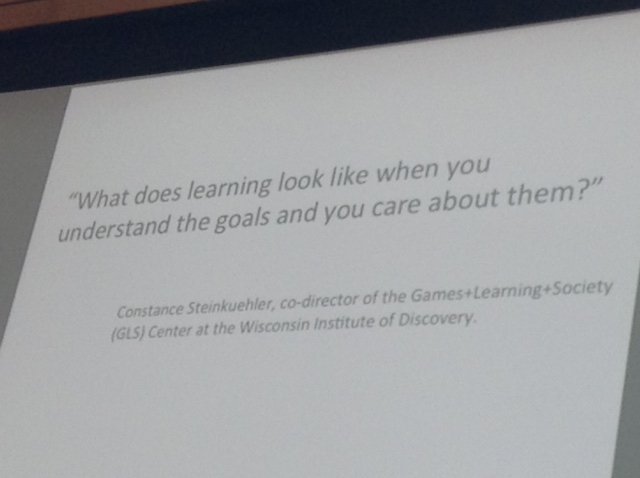Searching for "online learning"
Polls and surveys tools for education
SCSU faculty asked for help with Kahoot.it Great tool. Especially the reward system, which most likely might engage students in the learning process. However, Kahoot is very “synchronous.” It assumes that the faculty is in a synchronous environment (F2F or online). At least the free version.
In 2012, six SCSU faculty members worked together and recommended “heavy duty” survey/polling options also known as Classroom Response Systems (CRS):
https://blog.stcloudstate.edu/ims/?s=clickers
Among the considered vendors were Turning Technologies, which have both hardware and completely online option and integrate with D2L (https://blog.stcloudstate.edu/ims/2013/09/10/crs-clickers-turning-technology-instructions/) and TopHatMonitor (https://blog.stcloudstate.edu/ims/2013/04/10/clickers-documentation/), which is completely online, no hardware solution.
Here are additional free resources, as recommended for use in education:
http://www.educatorstechnology.com/2012/05/15-great-free-and-easy-survey-polls.html
1- Kwiqpoll (my note: seems out of business)
This is a simple poll making tool. It does not require any registration. Just visit the homepage and start creating you poll right away. You have the choice to provide multiple choice answers. You will also be provided with a generated URL to use when sharing your polls.
2- Flisti
This is another great simple poll tool. It is very easy to use and resembles Kwiqpoll in that it does not call for any sign up. Just head over to its main page and start working on your poll. You can add as many answers as you want to your poll. Again , you can embed your polls in your blog, wiki or website
3- Urtak (my note: dead – server not found message)
This tool allows users to create polls using yes or no multiple questions.
4- Vorbeo (my note: seems out of business)
This is another free and simple to use poll tool. Teachers can use it to create their own polls and customize them the way they want by adding colours, adjusting width and many more before sharing them on their blogs or websites.
5- Polldaddy
This is another popular polling service that allows users to create free polls and surveys containing up to ten questions.
6- Micropoll
Micropoll allows users to instantly create a poll using a set of questions and answers then one email address. It also provides embed codes to share polls online.
8- Obsurvey
This is a great utility for creating instant surveys. It is dead simple, just visit its main page , type in your questions and answers using their text editor and there you go.
9- Kwik Surveys
This is another great polling service. It allows users to design their own surveys, form, polls and feedback forms. It is free but it does require a sign up.
10- Polleverywhere
This is a great polling tool. It has different pricing plans and also has a free plan but very limited and allows for just 40 responses per poll.
12- Poll Junkie
This is a simple free service for creating instant polls. It lets users specify an expiry date for their polls and also opt for email notification to be notified each time there is an answer to the poll.
13- Yarp
This is another easy and simple poll creating tool. It basically allows users to create their own surveys or online invitations. It does not require any registration.
7 Things You Should Know About Developments in Instructional Design
http://www.educause.edu/library/resources/7-things-you-should-know-about-developments-instructional-design
Please read the entire EducCause article here: eli7120
discussion of IMS with faculty:
- pedagogical theories
- learning outcome
- design activities
- students’ multimedia assignments, which lead to online resources
- collaboration with other departments for the students projects
- moving the class to online environment (even if kept hybrid)
What is it?
the complexity of the learning environment is turning instructional design into a more dynamic activity, responding to changing educational models and expectations. Flipped classrooms, makerspaces, and competency-based learning are changing how instructors work with students, how students work with course content, and how mastery is verified. Mobile computing, cloud computing, and data-rich repositories have altered ideas about where and how learning takes place.
How does it work?
One consequence of these changes is that designers can find themselves filling a variety of roles. Today’s instructional designer might work with subject-matter experts, coders, graphic designers, and others. Moreover, the work of an instructional designer increasingly continues throughout the duration of a course rather than taking place upfront.
Who’s doing it?
The responsibility for designing instruction traditionally fell to the instructor of a course, and in many cases it continues to do so. Given the expanding role and landscape of technology—as well as the growing body of knowledge about learning and about educational activities and assessments— dedicated instructional designers are increasingly common and often take a stronger role.
Why is it significant?
The focus on student-centered learning, for example, has spurred the creation of complex integrated learning environments that comprise multiple instructional modules. Competency-based learning allows students to progress at their own pace and finish assignments, courses, and degree plans as time and skills permit. Data provided by analytics systems can help instructional designers predict which pedagogical approaches might be most effective and tailor learning experiences accordingly. The use of mobile learning continues to grow, enabling new kinds of learning experiences.
What are the downsides?
Given the range of competencies needed for the position, finding and hiring instructional designers who fit well into particular institutional cultures can be challenging to the extent that instructors hand over greater amounts of the design process to instructional designers, some of those instructors will feel that they are giving up control, which, in some cases, might appear to be simply the latest threat to faculty authority and autonomy. My note: and this is why SCSU Academic Technology is lead by faculty not IT staff.
Where is it going?
In some contexts, instructional designers might work more directly with students, teaching them lifelong learning skills. Students might begin coursework by choosing from a menu of options, creating their own path through content, making choices about learning options, being more hands-on, and selecting best approaches for demonstrating mastery. Educational models that feature adaptive and personalized learning will increasingly be a focus of instructional design. My note: SCSU CETL does not understand instructional design tendencies AT ALL. Instead of grooming faculty to assume the the leadership role and fill out the demand for instructional design, it isolates and downgrades (keeping traditional and old-fashioned) instructional design to basic tasks of technicalities done by IT staff.
What are the implications for teaching and learning?
By helping align educational activities with a growing understanding of the conditions,
tools, and techniques that enable better learning, instructional designers can help higher education take full advantage of new and emerging models of education. Instructional
designers bring a cross-disciplinary approach to their work, showing faculty how learning activities used in particular subject areas might be effective in others. In this way, instructional
designers can cultivate a measure of consistency across courses and disciplines in how educational strategies and techniques are incorporated. Designers can also facilitate the
creation of inclusive learning environments that offer choices to students with varying strengths and preferences.
More on instructional design in this IMS blog:
https://blog.stcloudstate.edu/ims/2014/10/13/instructional-design/
Tumbleson, B. E., & Burke, J. (. J. (2013). Embedding librarianship in learning management systems: A how-to-do-it manual for librarians. Neal-Schuman, an imprint of the American Library Association.
|
 |
https://scsu.mplus.mnpals.net/vufind/Record/007650037
see also:
Kvenild, C., & Calkins, K. (2011).
Embedded Librarians: Moving Beyond One-Shot Instruction – Books / Professional Development – Books for Academic Librarians – ALA Store. ACRL. Retrieved from
http://www.alastore.ala.org/detail.aspx?ID=3413
p. 20 Embedding Academic and Research Libraries in the Curriculum: 2014-nmc-horizon-report-library-EN
xi. the authors are convinced that LMS embedded librarianship is becoming he primary and most productive method for connecting with college and university students, who are increasingly mobile.
xii. reference librarians engage the individual, listen, discover what is wanted and seek to point the stakeholder in profitable directions.
Instruction librarians, in contrast, step into the classroom and attempt to lead a group of students in new ways of searching wanted information.
Sometimes that instruction librarian even designs curriculum and teaches their own credit course to guide information seekers in the ways of finding, evaluating, and using information published in various formats.
Librarians also work in systems, emerging technologies, and digital initiatives in order to provide infrastructure or improve access to collections and services for tend users through the library website, discovery layers, etc. Although these arenas seemingly differ, librarians work as one.
xiii. working as an LMS embedded librarian is both a proactive approach to library instruction using available technologies and enabling a 24/7 presence.
1. Embeddedness involves more that just gaining perspective. It also allows the outsider to become part of the group through shared learning experiences and goals. 3. Embedded librarianship in the LMS is all about being as close as possible to where students are receiving their assignments and gaining instruction and advice from faculty members. p. 6 When embedded librarians provide ready access to scholarly electronic collections, research databases, and Web 2.0 tools and tutorials, the research experience becomes less frustrating and more focused for students. Undergraduate associate this familiar online environment with the academic world.
p. 7 describes embedding a reference librarian, which LRS reference librarians do, “partnership with the professor.” However, there is room for “Research Consultations” (p. 8). While “One-Shot Library Instruction Sessions” and “Information Literacy Credit Courses” are addressed (p. 809), the content of these sessions remains in the old-fashioned lecturing type of delivering the information.
p. 10-11. The manuscript points out clearly the weaknesses of using a Library Web site. The authors fail to see that the efforts of the academic librarians must go beyond Web page and seek how to easy the information access by integrating the power of social media with the static information residing on the library web page.
p. 12 what becomes disturbingly clear is that faculty focus on the mechanics of the research paper over the research process. Although students are using libraries, 70 % avoid librarians. Urging academic librarians to “take an active role and initiate the dialogue with faculty to close a divide that may be growing between them and faculty and between them and students.”
Four research context with which undergraduates struggle: big picture, language, situational context and information gathering.
p. 15 ACRL standards One and Three: librarians might engage students who rely on their smartphones, while keeping in mind that “[s]tudents who retrieve information on their smartphones may also have trouble understanding or evaluating how the information on their phone is ‘produced, organized, and disseminated’ (Standard One).
Standard One by its definition seems obsolete. If information is formatted for desktops, it will be confusing when on smart phones, And by that, it is not mean to adjust the screen size, but change the information delivery from old fashioned lecturing to more constructivist forms. e.g. http://web.stcloudstate.edu/pmiltenoff/bi/
p. 15 As for Standard Two, which deals with effective search strategies, the LMS embedded librarian must go beyond Boolean operators and controlled vocabulary, since emerging technologies incorporate new means of searching. As unsuccessfully explained to me for about two years now at LRS: hashtag search, LinkedIn groups etc, QR codes, voice recognition etc.
p. 16. Standard Five. ethical and legal use of information.
p. 23 Person announced in 2011 OpenClass compete with BB, Moodle, Angel, D2L, WebCT, Sakai and other
p. 24 Common Features: content, email, discussion board, , synchronous chat and conferencing tools (Wimba and Elluminate for BB)
p. 31 information and resources which librarians could share via LMS
– post links to dbases and other resources within the course. LIB web site, LibGuides or other subject-related course guidelines
– information on research concepts can be placed in a similar fashion. brief explanation of key information literacy topics (e.g difference between scholarly and popular periodical articles, choosing or narrowing research topics, avoiding plagiarism, citing sources properly whining required citations style, understanding the merits of different types of sources (Articles book’s website etc)
– Pertinent advice the students on approaching the assignment and got to rheank needed information
– Tutorials on using databases or planning searches step-by-step screencast navigating in search and Candida bass video search of the library did you a tour of the library
p. 33 embedded librarian being copied on the blanked emails from instructor to students.
librarian monitors the discussion board
p. 35 examples: students place specific questions on the discussion board and are assured librarian to reply by a certain time
instead of F2F instruction, created a D2L module, which can be placed in any course. videos, docls, links to dbases, links to citation tools etc. Quiz, which faculty can use to asses the the students
p. 36 discussion forum just for the embedded librarian. for the students, but faculty are encouraged to monitor it and provide content- or assignment-specific input
video tutorials and searching tips
Contact information email phone active IM chat information on the library’s open hours
p. 37 questions to consider
what is the status of the embedded librarian: T2, grad assistant
p. 41 pilot program. small scale trial which is run to discover and correct potential problems before
One or two faculty members, with faculty from a single department
Pilot at Valdosta State U = a drop-in informatil session with the hope of serving the information literacy needs of distance and online students, whereas at George Washington U, librarian contacted a distance education faculty member to request embedding in his upcoming online Mater’s course
p. 43 when librarians sense that current public services are not being fully utilized, it may signal that a new approach is needed.
pilots permit tinkering. they are all about risk-taking to enhance delivery
p. 57 markeing LMS ebedded Librarianship
library collections, services and facilities because faculty may be uncertain how the service benefits their classroom teaching and learning outcomes.
my note per
“it is incumbent upon librarians to promote this new mode of information literacy instruction.” it is so passe. in the times when digital humanities is discussed and faculty across campus delves into digital humanities, which de facto absorbs digital literacy, it is shortsighted for academic librarians to still limit themselves into “information literacy,” considering that lip service is paid for for librarians being the leaders in the digital humanities movement. If academic librarians want to market themselves, they have to think broad and start with topics, which ARE of interest for the campus faculty (digital humanities included) and then “push” their agenda (information literacy). One of the reasons why academic libraries are sinking into oblivion is because they are sunk already in 1990-ish practices (information literacy) and miss the “hip” trends, which are of interest for faculty and students. The authors (also paying lip services to the 21st century necessities), remain imprisoned to archaic content. In the times, when multi (meta) literacies are discussed as the goal for library instruction, they push for more arduous marketing of limited content. Indeed, marketing is needed, but the best marketing is by delivering modern and user-sought content.
the stigma of “academic librarians keep doing what they know well, just do it better.” Lip-services to change, and life-long learning. But the truth is that the commitment to “information literacy” versus the necessity to provide multi (meta) literacites instruction (Reframing Information Literacy as a metaliteracy) is minimizing the entire idea of academic librarians reninventing themselves in the 21st century.
Here is more: NRNT-New Roles for New Times
p. 58 According to the Burke and Tumbleson national LMS embedded librarianship survey, 280 participants yielded the following data regarding embedded librarianship:
- traditional F2F LMS courses – 69%
- online courses – 70%
- hybrid courses – 54%
- undergraduate LMS courses 61%
- graduate LMS courses 42%
of those respondents in 2011, 18% had the imitative started for four or more years, which place the program in 2007. Thus, SCSU is almost a decade behind.
p. 58 promotional methods:
- word of mouth
- personal invitation by librarians
- email by librarians
- library brochures
- library blogs
four years later, the LRS reference librarians’ report https://magic.piktochart.com/output/5704744-libsmart-stats-1415 has no mentioning of online courses, less to say embedded librarianship
my note:
library blog was offered numerous times to the LRS librarians and, consequently to the LRS dean, but it was brushed away, as were brushed away the proposals for modern institutional social media approach (social media at LRS does not favor proficiency in social media but rather sees social media as learning ground for novices, as per 11:45 AM visit to LRS social media meeting of May 6, 2015). The idea of the blog advantages to static HTML page was explained in length, but it was visible that the advantages are not understood, as it is not understood the difference of Web 2.0 tools (such as social media) and Web 1.0 tools (such as static web page). The consensus among LRS staff and faculty is to keep projecting Web 1.0 ideas on Web 2.0 tools (e.g. using Facebook as a replacement of Adobe Dreamweaver: instead of learning how to create static HTML pages to broadcast static information, use Facebook for fast and dirty announcement of static information). It is flabbergasting to be rejected offering a blog to replace Web 1.0 in times when the corporate world promotes live-streaming (http://www.socialmediaexaminer.com/live-streaming-video-for-business/) as a way to promote services (academic librarians can deliver live their content)
p. 59 Marketing 2.0 in the information age is consumer-oriented. Marketing 3.0 in the values-driven era, which touches the human spirit (Kotler, Katajaya, and Setiawan 2010, 6).
The four Ps: products and services, place, price and promotion. Libraries should consider two more P’s: positioning and politics.
Mathews (2009) “library advertising should focus on the lifestyle of students. the academic library advertising to students today needs to be: “tangible, experiential, relatebale, measurable, sharable and surprising.” Leboff (2011, p. 400 agrees with Mathews: the battle in the marketplace is not longer for transaction, it is for attention. Formerly: billboards, magazines, newspapers, radio, tv, direct calls. Today: emphasize conversation, authenticity, values, establishing credibility and demonstrating expertise and knowledge by supplying good content, to enhance reputation (Leboff, 2011, 134). translated for the embedded librarians: Google goes that far; students want answers to their personal research dillemas and questions. Being a credentialed information specialist with years of experience is no longer enough to win over an admiring following. the embedded librarian must be seen as open and honest in his interaction with students.
p. 60 becoming attractive to end-users is the essential message in advertising LMS embedded librarianship. That attractivness relies upon two elements: being noticed and imparting values (Leboff, 2011, 99)
p. 61 connecting with faculty
p. 62 reaching students
- attending a synchronous chat sessions
- watching a digital tutorial
- posting a question in a discussion board
- using an instant messaging widget
be careful not to overload students with too much information. don’t make contact too frequently and be perceived as an annoyance and intruder.
p. 65. contemporary publicity and advertising is incorporating storytelling. testimonials differ from stories
p. 66 no-cost marketing. social media
low-cost marketing – print materials, fliers, bookmarks, posters, floor plans, newsletters, giveaways (pens, magnets, USB drives), events (orientations, workshops, contests, film viewings), campus media, digital media (lib web page, blogs, podcasts, social networking cites
p. 69 Instructional Content and Instructional Design
p. 70 ADDIE Model


Analysis: the requirements for the given course, assignments.
Ask instructors expectations from students vis-a-vis research or information literacy activities
students knowledge about the library already related to their assignments
which are the essential resources for this course
is this a hybrid or online course and what are the options for the librarian to interact with the students.
due date for the research assignment. what is the timeline for completing the assignment
when research tips or any other librarian help can be inserted
copy of the syllabus or any other assignment document
p. 72 discuss the course with faculty member. Analyze the instructional needs of a course. Analyze students needs. Create list of goals. E.g.: how to find navigate and use the PschInfo dbase; how to create citations in APA format; be able to identify scholarly sources and differentiate them from popular sources; know other subject-related dbases to search; be able to create a bibliography and use in-text citations in APA format
p. 74 Design (Addie)
the embedded component is a course within a course. Add pre-developed IL components to the broader content of the course. multiple means of contact information for the librarians and /or other library staff. link to dbases. link to citation guidance and or tutorial on APA citations. information on how to distinguish scholarly and popular sources. links to other dbases. information and guidance on bibliographic and in-text citations n APA either through link, content written within the course a tutorial or combination. forum or a discussion board topic to take questions. f2f lib instruction session with students
p. 76 decide which resources to focus on and which skills to teach and reinforce. focus on key resources
p. 77 development (Addie).
-building content;the “landing” page at LRS is the subject guides page. resources integrated into the assignment pages. video tutorials and screencasts
-finding existing content; google search of e.g.: “library handout narrowing topic” or “library quiz evaluating sources,” “avoiding plagiarism,” scholarly vs popular periodicals etc
-writing narrative content. p. 85
p. 87 Evaluation (Addie)
formative: to change what the embedded librarian offers to improve h/er services to students for the reminder of the course
summative at the end of the course:
p. 89 Online, F2F and Hybrid Courses
p. 97 assessment impact of embedded librarian.
what is the purpose of the assessment; who is the audience; what will focus on; what resources are available
p. 98 surveys of faculty; of students; analysis of student research assignments; focus groups of students and faculty
p. 100 assessment methods: p. 103/4 survey template
https://www.ets.org/iskills/about
https://www.projectsails.org/ (paid)
http://www.trails-9.org/
http://www.library.ualberta.ca/augustana/infolit/wassail/
p. 106 gathering LMS stats. Usability testing
examples: p. 108-9, UofFL : pre-survey and post-survey of studs perceptions of library skills, discussion forum analysis and interview with the instructor
p. 122 create an LMS module for reuse (standardized template)
p. 123 subject and course LibGuides, digital tutorials, PPTs,
research mind maps, charts, logs, or rubrics
http://creately.com/blog/wp-content/uploads/2012/12/Research-Proposal-mind-map-example.png
http://www.library.arizona.edu/help/tutorials/mindMap/sample.php (excellent)
or paper-based if needed: Concept Map Worksheet
Productivity Tools for Graduate Students: MindMapping http://libguides.gatech.edu/c.php
rubrics:
http://www.cornellcollege.edu/LIBRARY/faculty/focusing-on-assignments/tools-for-assessment/research-paper-rubric.shtml
http://gvsu.edu/library/instruction/research-guidance-rubric-for-assignment-design-4.htm
Creating Effective Information Literacy Assignments http://www.lib.jmu.edu/instruction/assignments.aspx
course handouts
guides on research concepts http://library.olivet.edu/subject-guides/english/college-writing-ii/research-concepts/
http://louisville.libguides.com/c.php
Popular versus scholar http://www.library.arizona.edu/help/tutorials/scholarly/guide.html
list of frequently asked q/s:
blog posts
banks of reference q/s
p. 124. Resistance or Receptivity
p. 133 getting admin access to LMS for the librarians.
p. 136 mobile students, dominance of born-digital resources
———————-
Summey T, Valenti S. But we don’t have an instructional designer: Designing online library instruction using isd techniques. Journal Of Library & Information Services In Distance Learning [serial online]. January 1, 2013;Available from: Scopus®, Ipswich, MA. Accessed May 11, 2015.
http://login.libproxy.stcloudstate.edu/login?qurl=http%3a%2f%2fsearch.ebscohost.com%2flogin.aspx%3fdirect%3dtrue%26db%3dedselc%26AN%3dedselc.2-52.0-84869866367%26site%3deds-live%26scope%3dsite
instructional designer library instruction using ISD techniques
Shank, J. (2006). The blended librarian: A job announcement analysis of the newly emerging position of instructional design librarian. College And Research Libraries, 67(6), 515-524.
http://login.libproxy.stcloudstate.edu/login?qurl=http%3a%2f%2fsearch.ebscohost.com%2flogin.aspx%3fdirect%3dtrue%26db%3dedselc%26AN%3dedselc.2-52.0-33845291135%26site%3deds-live%26scope%3dsite
The Blended Librarian_ A Job Announcement Analysis of the Newly Emerging Position of Instructional Design Librarian
Macklin, A. (2003). Theory into practice: Applying David Jonassen’s work in instructional design to instruction programs in academic libraries. College And Research Libraries, 64(6), 494-500.
http://login.libproxy.stcloudstate.edu/login?qurl=http%3a%2f%2fsearch.ebscohost.com%2flogin.aspx%3fdirect%3dtrue%26db%3dedselc%26AN%3dedselc.2-52.0-7044266019%26site%3deds-live%26scope%3dsite
Theory into Practice_ Applying David Jonassen_s Work in Instructional Design to Instruction Programs in Academic Libraries
Walster, D. (1995). Using Instructional Design Theories in Library and Information Science Education. Journal of Education for Library and Information Science, (3). 239.
http://login.libproxy.stcloudstate.edu/login?qurl=http%3a%2f%2fsearch.ebscohost.com%2flogin.aspx%3fdirect%3dtrue%26db%3dedsjsr%26AN%3dedsjsr.10.2307.40323743%26site%3deds-live%26scope%3dsite
Using Instructional Design Theories in Library and Information Science Education
Mackey, T. )., & Jacobson, T. ). (2011). Reframing information literacy as a metaliteracy. College And Research Libraries, 72(1), 62-78.
http://login.libproxy.stcloudstate.edu/login?qurl=http%3a%2f%2fsearch.ebscohost.com%2flogin.aspx%3fdirect%3dtrue%26db%3dedselc%26AN%3dedselc.2-52.0-79955018169%26site%3deds-live%26scope%3dsite
Reframing Information Literacy as a metaliteracy
Nichols, J. (2009). The 3 directions: Situated information literacy. College And Research Libraries, 70(6), 515-530.
http://login.libproxy.stcloudstate.edu/login?qurl=http%3a%2f%2fsearch.ebscohost.com%2flogin.aspx%3fdirect%3dtrue%26db%3dedselc%26AN%3dedselc.2-52.0-73949087581%26site%3deds-live%26scope%3dsite
The 3 Directions_ Situated literacy
—————
Journal of Library & Information Services in Distance Learning (J Libr Inform Serv Dist Learn)
https://www.researchgate.net/journal/1533-290X_Journal_of_Library_Information_Services_in_Distance_Learning
http://conference.acrl.org/
http://www.loex.org/conferences.php
http://www.ala.org/lita/about/igs/distance/lit-igdl
————
https://magic.piktochart.com/output/5704744-libsmart-stats-1415
Voice over presentation
Faculty request to lay voice over a presentation with pictures. Solutions:
Windows / PC

ppt voice over
Apple/Mac

voice over PPT on Apple
advantages:
– unfortunately, faculty are way too familiar with PPT. Familiar to the point that they don’t want to try something better.
– FERPA complient
disadvantages:
– too old. PPT is pre-Internet. It does not matter how much Microsoft is trying to adapt it, the concept is old. There is a myriad of cloud-based solutions, which do better job: https://blog.stcloudstate.edu/ims/2013/09/30/the-5-best-free-slideshow-presentation-and-creation-tools-for-teachers/
– too many files, too many variations
– PPT posted in D2L displays in the D2L Viewer. The visuals are there, but the voice is not. In order to hear the voice, students must download the presentation. Faculty must reflect this in the syllabus.
– faculty need to know how to upload on their web space and figure out URL, if PPT is not place in LMS (D2L)- if faculty places PPT in LMS (D2L), then it is behind password; nearly impossible to share (can share only with SCSU and/or MnSCU members.
– faculty must remember to indicate in the syllabus and/or D2L / Content that “in order to hear the voice over, user must download presentation.”

slideshare
advantages:
– it is a “social” app, like LinkedIn and Twitter. Tagged correctly, the presentation is a platform for “same-minded” people to discuss mutual interests.
– excellent for sharing: conferences, MOOCs etc.
– it has discussion group in LinkedIn.
disadvantages:
– voice over presentation: way to cumbersome compared to PPT. Watch their presentation
– by FERPA regulations, if the presentation contains personal data about students, it cannot be shared on SlideShare
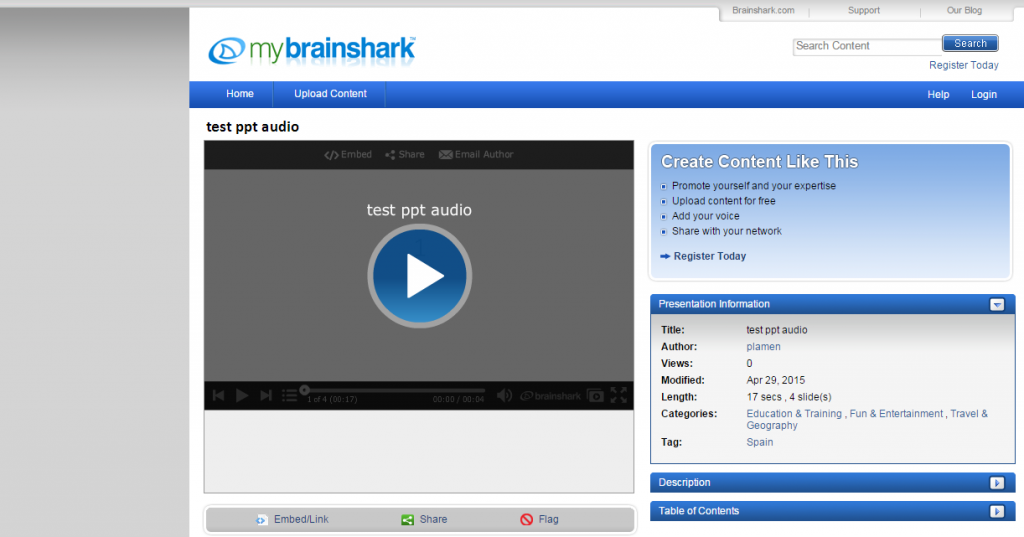
mybrainshaark
advantages:
– it is a “social” app, like LinkedIn and Twitter. Tagged correctly, the presentation is a platform for “same-minded” people to discuss mutual interests.
– excellent for sharing: conferences, MOOCs etc.
– like PPT, very easy upload of pix and voice over. Better the PPT, since it is online and easy to distribute.
– easy to upload PPT and easy to voice over each slide
disadvantages:
– does not embed in D2L (it is D2L issue, not the app), but works perfectly as a link
– faculty must remember to indicate in the syllabus and/or D2L / Content that when clicking on the URL to the PPT, user must simultaneously press “Ctrl” key to open PPT in a separate browser window or tab
– by FERPA regulations, if the presentation contains personal data about students, it cannot be shared on SlideShare

voicethread
advantages:
– consistently voted through last 5 years by K12 educators as great interactive tool.
– video, images, audio and text.
– “constructivist” premiss: teacher and students can exchange asynchronously ideas by using images, video, text and audio.
disadvantages:
– free option has limited features.
– by FERPA regulations, if the presentation contains personal data about students, it cannot be shared on on this site.

mediasite
advantages:
– crude screen capture: faculty can run the PPT manually and narrate over it.
– dirty but fast
– easily shared online (URL ready)
– FERPA compliant
disadvantages:
– students cannot comment (compared to VoiceThread)
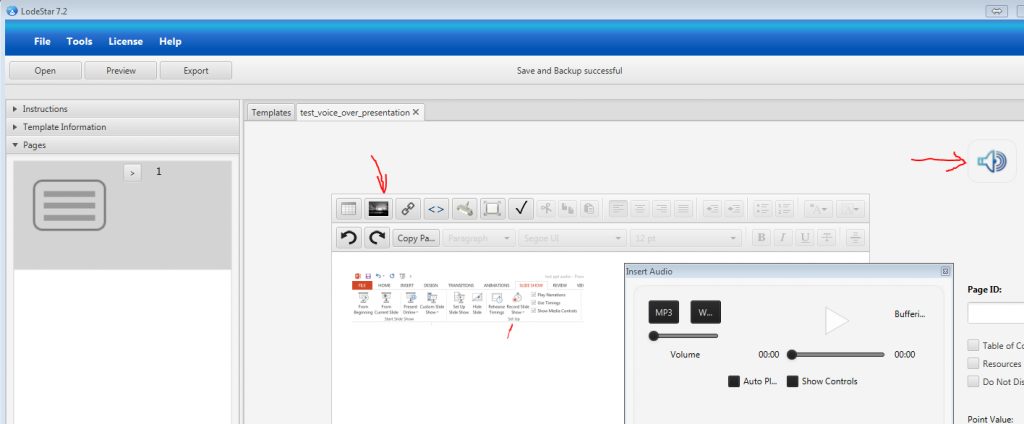
- lodestar
advantages:
– free: http://lodestarlearning.com/downloads/lodeStar7.2/en/LodeStar-7.0.exe
– easy to use
– FERPA compliant; endorsed by MnSCU
disadvantages:
– voice over too complex (very much the same as with SlideShare)
advantages:
– FERPA compliant; endorsed by MnSCU
disadvantages:
–
I have not included TechSmit’s Jing https://www.techsmith.com/jing.html, because their video output (Flash file) is obsolete and impossible to convert for free. While it still can be played, shall faculty want to upload the video file on Youtube or similar social media, it will be impossible.
———————————-
Related IMS blog entries:
https://blog.stcloudstate.edu/ims/2014/06/01/social-media-and-presentations-free-image-sources/
https://blog.stcloudstate.edu/ims/2013/09/30/the-5-best-free-slideshow-presentation-and-creation-tools-for-teachers/
16 Startups Poised to Disrupt the Education Market
Colleges and universities are facing new competition for customers–students and their parents–from startups delivering similar goods (knowledge, credentials, prestige) more affordably and efficiently. Here’s a rundown of some of those startups.
Related story on the IMS blog:
https://blog.stcloudstate.edu/ims/2014/01/12/cms-course-management-systemsoftware-alternatives/
In a new book, The End of College: Creating the Future of Learning and the University of Everywhere, author Kevin Carey distills a brave new world in which a myriad of lower-cost solutions–most in their infancy–threaten to upend the four-year, high-tuition business model by which colleges and universities have traditionally thrived.
1. Rafter
Using cloud-based e-textbooks and course materials, Rafter helps campus bookstores digitize their offerings and keep their prices low, allowing them to regain the market share they were losing to other stores and course-materials marketplaces.
2. Piazza
Piazza is an online study room where students can anonymously ask questions to teachers and other students. The best answers get pushed to the top through repeated user endorsement.
3. InsideTrack
As do the above two companies, InsideTrack sells its services to universities. It provides highly personalized coaching to students and it helps colleges assess whether their technology and processes are equipped to measure student progress. nsideTrack recently announced a partnership with Chegg, through which it will provide its coaching services directly to students.
4. USEED
If you attended a four-year school, then you know the feeling of receiving relentless requests for alumni donations. USEED is like Kickstarter for school fundraising:
5. Course Hero
One of Inc.‘s 30-Under-30 companies from 2013, Course Hero is an online source of study guides, class notes, past exams, flash cards, and tutoring services.
6. Quizlet
This is another site offering shared learning tools from students worldwide. Quizlet
according to Tony Wan’s superb story on EdSurge.
7. The Minerva Project
Other companies on this list provide services to schools or students. The Minerva Project is, literally, a new school.
8. Dev Bootcamp
In its own way, Dev Bootcamp is also a new school. Its program allows you to become a Web developer after a 19-week course costing under $14,000.
9. The UnCollege Movement
Founded by Thiel Fellow Dale Stephens (who took $100,000 from Peter Thiel to not go to college), The UnCollege Movement provides students with a 12-month Gap Year experience for $16,000.
10. Udacity
Founded by Stanford computer science professor Sebastian Thrun, Udacity creates online classes through which companies can train employees. AT&T, for example, paid Udacity $3 million to develop a series of courses, according to The Wall Street Journal.
11. Coursera
The tagline says it all: “Free online courses from top universities.” Indeed, Coursera’s partners include prestigious universities worldwide.
12. EdX
In a nonprofit joint venture, MIT and Harvard created their own organization offering free online courses from top universities. Several other schools now offer their courses through EdX, including Berkeley, Georgetown, and the University of Texas system.
13. Carnegie Mellon University’s Open Learning Initiative
CMU’s OLI is another example of a nonprofit startup founded by a school to ward off its own potential disruption.
14. Saylor.org
Founder Michael Saylor has been musing on how technology can scale education since he himself was an undergrad at MIT in the early ’80s. Anyone, anywhere, can take courses on Saylor.org for free.
15. Open Badges
Founded by Mozilla, Open Badges is an attempt to establish “a new online standard to recognize and verify learning.”
16. Accredible
Calling itself the “future of certificate management,” Accredible is the company that provides certification services for several of the online schools on this list, including Saylor.org and Udacity.
What MOOCs Are Teaching Universities About Active Learning
http://ww2.kqed.org/mindshift/2014/10/30/what-moocs-are-teaching-universities-about-active-learning/
Academy of distinguished teachers, Innovation
University of Minnesota, McNamara Alumni Center – Twin Cities Campus. April 8, 2015
Full program available here: https://guidebook.com/g/adt/

Randy Bass
Randy Bass
https://www.linkedin.com/pub/randall-bass/14/94/77
flipping disruption into Design
there are two type of universities: the ones that are in control of change and the ones, which are pressed to change.
what kind of education is needed at this moment of history.
Assumptions: 5-10 years will be for a first time outcompeted in terms of delivering information and degrees. What is that the university can do distinctively well that WWW cannot do: mentored learning and the arc of learning (beyond collection of granular separate learning)
book: The New Division of Labor. http://www.amazon.com/The-New-Division-Labor-Computers/dp/0691124027
External forces of potential disruption: 1. MOOCs, nearly free education, 2. skilled-based learning (Codeacademy, Udacity), 3. data analytic 4. public pressure on access, metrics of impact.
Gartner group (http://www.gartner.com/technology/home.jsp) hype cycle : overvalued in a short term and undervalued in a long term. MOOC is excellent example.
NMC: competing models of education.
learning analytics. adaptive learning, intelligent tutoring etc. Open Learning Initative. http://oli.cmu.edu/
In the 19th century, railroads companies which were in the business of railroad companies went under; the ones which were in the business of transportation survived. Parallel, universities, which are in the business of delivering information will die out; the ones, which will survive must look to a very different picture.

formative wider outcomes
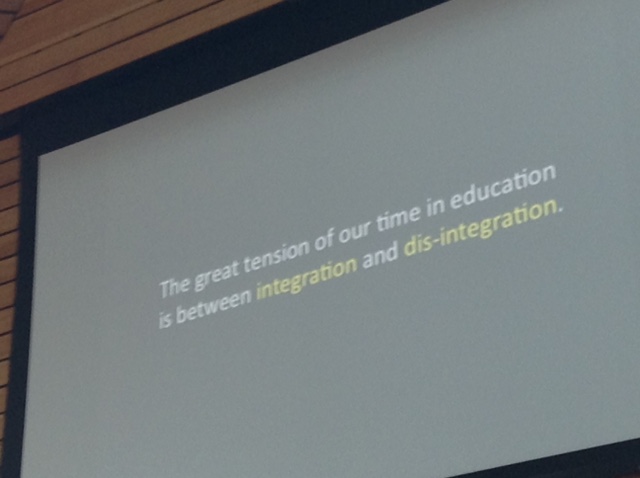
integration and dis-integration
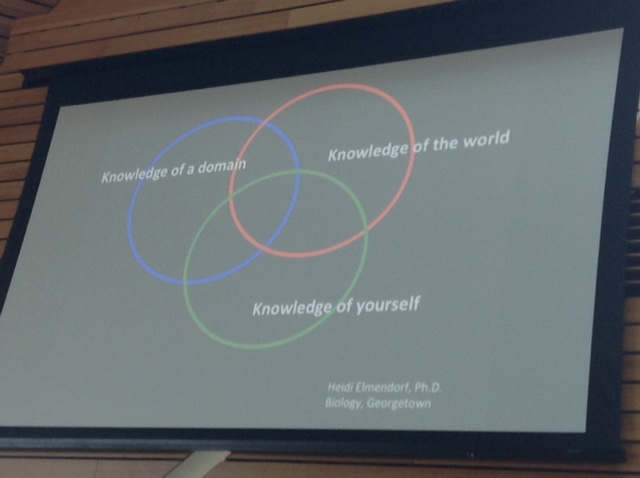
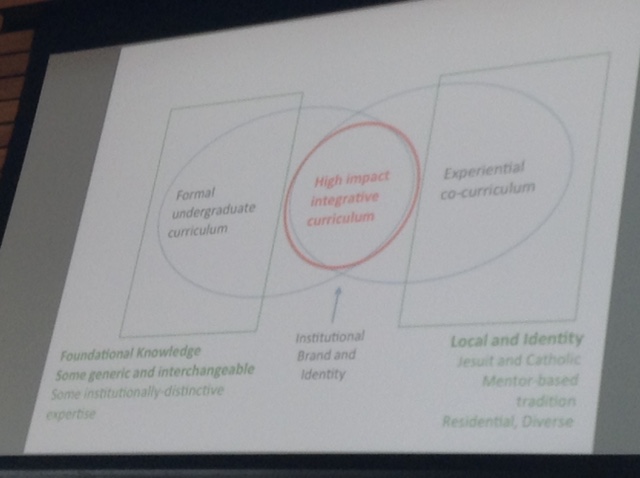
high impact integrative curriculum

what makes high inpact practices high impact
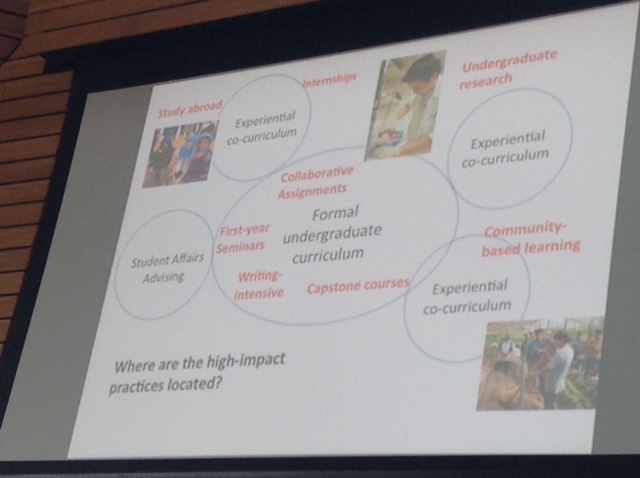
formal versus informal
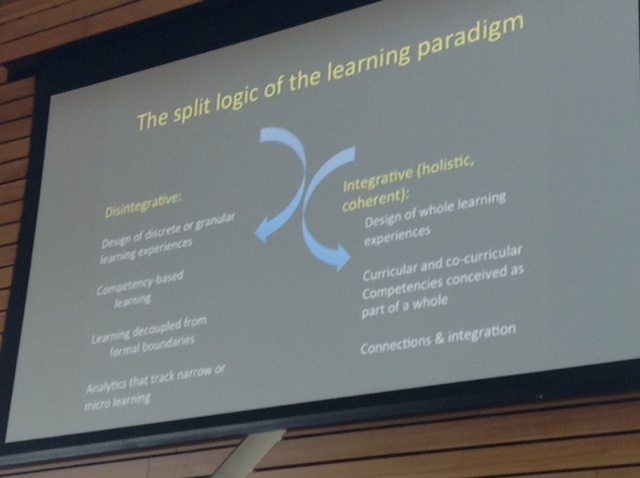
Selected sessions:
The Value of Assessing Outcomes of Teaching Methodologies to guide instructional design
https://guidebook.com/guide/33541/event/10594685/
game-based learning:
Upping your Game – Best Practices in Using Game-Based Learning
https://guidebook.com/guide/33541/event/10594684/
Implementing Game Dynamics in Moodle
https://guidebook.com/guide/33541/event/10693434/
visuals:
Engaging Students through Video Integration
https://guidebook.com/guide/33541/event/10676389/
https://guidebook.com/guide/33541/event/10676375/
Using Flipgrid Video Commentary to Share Student Learning
https://guidebook.com/guide/33541/event/10676361/
————
Enhancing learning with online narrated presentations using VoiceThread
https://guidebook.com/guide/33541/event/10676372/
flipped:
Essential Technology & Tools for Flipping Your Classroom
https://guidebook.com/guide/33541/event/10676385/
Improving Delivery of Technical Course Content through Incremental Use of Classroom “Flipping”
https://guidebook.com/guide/33541/event/10676376/
https://guidebook.com/guide/33541/event/10594850/
The Pros and Cons of Flipping the Classroom
https://guidebook.com/guide/33541/event/10676323/
Using Google Forms for Student Group Evaluations
https://guidebook.com/guide/33541/event/10734863/
Library:
The University Libraries Partnership for Affordable Content – Enhance Student Learning and Save Them Money!
https://guidebook.com/guide/33541/event/10676358/
CRS Tophat:
Using Classroom Debates as an Interactive Learning Tool in a Course on Companion Animal Ethical Issues
https://guidebook.com/guide/33541/event/10676369/
online:
Adapting the Harvard Case Method for Online Courses
https://guidebook.com/guide/33541/event/10595018/
Readiness Assessment for Online Courses
https://guidebook.com/guide/33541/event/10595040/

technology showcase general view
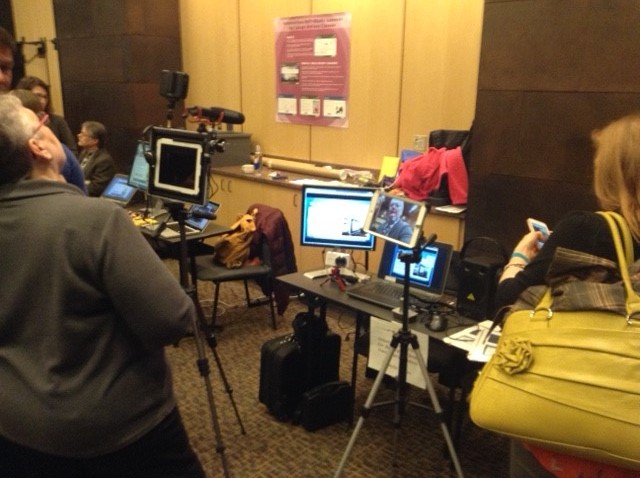
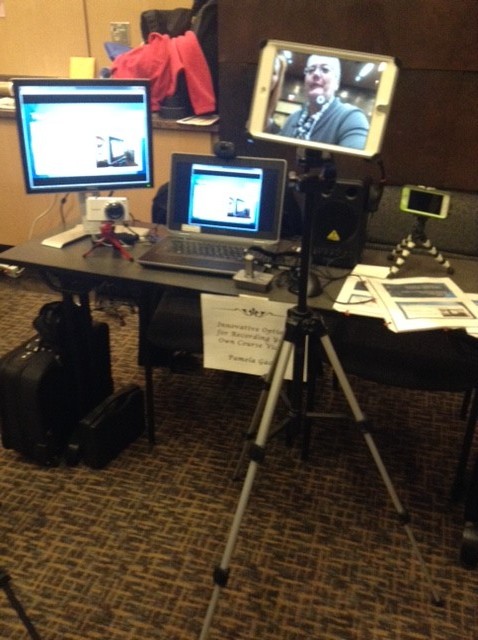
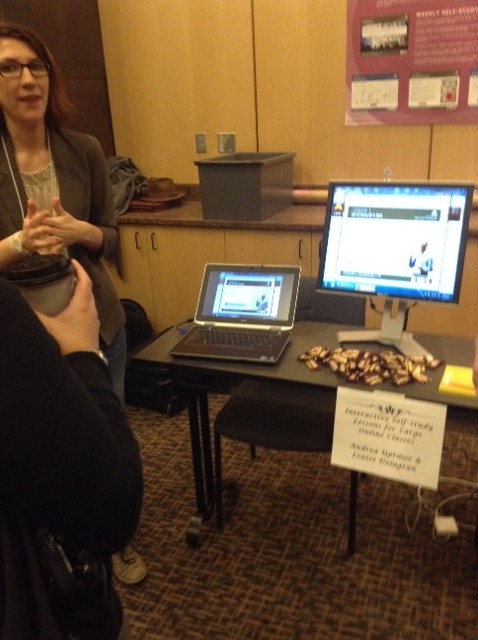


LITA discussion (attached below) on how one can easily do real-time but also big-data like estimate of patrons’ attendance in the library.
GitHub https://github.com/ and listuser@chillco.com Cary, for wifi connected counter
From: Cary Gordon [mailto:listuser@chillco.com]
Sent: Sunday, March 29, 2015 9:35 AM
To: lita-l@lists.ala.org
Subject: [lita-l] Re: patron/door counter
I am not an expert on door counters, but I think that it would be pretty simple — no, really — to make your own system using a small, inexpensive computer like a Raspberry Pi with a wifi adapter and connect it to your current counter. It would take a little programming, but the result could be something that the community could share.
If you are interested in this, we could create a project on GitHub. I would be happy to help.
Cary
On Mar 28, 2015, at 2:49 PM, Mason Yang <hyang@marymount.edu> wrote:
Hi,
We have a old door counter which can only be checked manually. We are looking for a new door counter system which can help us to find out how many patrons come in during certain hours. I found a couple systems online and would like know if some libraries recently installed any door counter systems and what’s your experience with them. I made a short list of questions below. If you can take a few minutes to answer those questions or just drop a line or two of your comments to reply to this email, I will really appreciate it.
Thanks in advance for your time and inputs!
- what’s the model and the brand of the door counter system?
- Wired to your network or wireless connected to the internet?
- Does the system count the number of entries/exists hourly?
- Dose the system generate reports,if any, automatically?
- What’s your general experience of the system?
- Will you recommend the system to other libraries?
Thanks,
—
Mason Yang
Electronic Services Librarian
Library & Learning Services
Marymount University
Phone: 703-526-6844
Fax: 703-284-1685
mason.yang@marymount.edu
Library Makerspaces: From Dream to Reality
Instructor: Melissa Robinson
Dates: April 6 to May 1st, 2015
Credits: 1.5 CEUs
Price: $175
http://libraryjuiceacademy.com/114-makerspaces.php
Designing a makerspace for your library is an ambitious project that requires significant staff time and energy. The economic, educational and inspirational rewards for your community and your library, however, will make it all worthwhile. This class will make the task of starting a makerspace less daunting by taking librarians step by step through the planning process. Using readings, online resources, discussions and hands-on exercises, participants will create a plan to bring a makerspace or maker activities to their libraries. Topics covered will include tools, programs, space, funding, partnerships and community outreach. This is a unique opportunity to learn in depth about one public library’s experience creating a fully-functioning makerspace, while also exploring other models for engaging libraries in the maker movement.
Melissa S. Robinson is the Senior Branch Librarian at the Peabody Institute Library’s West Branch in Peabody, Massachusetts. Melissa has over twelve years of experience in public libraries. She has a BA in political science from Merrimack College, a graduate certificate in Women in Politics and Public Policy from the University of Massachusetts Boston and a MLIS from Southern Connecticut State University. She is the co-author of Transforming Libraries, Building Communities (Scarecrow Press, 2013).
Read an interview with Melissa about this class:
http://libraryjuiceacademy.com/news/?p=733
Course Structure
This is an online class that is taught asynchronously, meaning that participants do the work on their own time as their schedules allow. The class does not meet together at any particular times, although the instructor may set up optional sychronous chat sessions. Instruction includes readings and assignments in one-week segments. Class participation is in an online forum environment.
Payment Info
You can register in this course through the first week of instruction. The “Register” button on the website goes to our credit card payment gateway, which may be used with personal or institutional credit cards. (Be sure to use the appropriate billing address). If your institution wants to pay using a purchase order, please contact us to make arrangements.
==============================
Making, Collaboration, and Community: fostering lifelong learning and innovation in a library makerspace
Tuesday, April 7, 2015 10AM-11:30AM PDT
Registration link: http://www.cla-net.org/?855
Travis Good will share insights garnered from having visited different makerspaces and Maker Faires across the country. He will explain why “making” is fundamentally important, what its affecting and why libraries are natural place to house makerspaces. Uyen Tran will discuss how without funding, she was able to turn a study room with two 3D printers into a simple makerspace that is funded and supported by the community. She will also provide strategies for working with community partners to provide free and innovative maker programs and creating a low cost/no cost library maker environment. Resources and programming ideas will also be provided for libraries with varying budgets and staffing. Upon completing this webinar, every attendee should be able to start implementing “maker” programs at their library.
Based on the literature regarding games, gaming, gamification, game-based learning, and serious games, several clear trends emerge:
- Gaming and gamification in the sense of game-based learning is about using games and game-like tactics in the education process, for greater engagement and better learning outcomes. However, this is only the first level of such initiative. The second and higher level is about involving students in the game-building and gamification of the learning process (as per Vygotsky’s Zone of…) thus achieving student-centered and experiential learning.
- When hosting games and gaming in any library, “in-person” or electronic/online games are welcome but not sufficient to fulfill their promise, especially in an academic library. Per (1), an academic library has the responsibility to involve students and guide them in learning how to engage in the building process required in true game-based learning.
- Game-based learning, gaming and gamification in particular, in educational (academic library) settings must consider mobile devices and the BYOD movement in particular as intrinsic parts of the entire process. Approaching the initiative primarily by acquiring online “in-person” games, or game consoles has the same limited educational potential as only hosting games, rather than elevating the students to full guided engagement with game-based learning. If public relations and raised profile are the main goals for the academic library, such an approach is justified. If the academic library seeks to maximize the value of game-based learning, then the library must consider: a. gaming consoles, b. mobile devices as part of a BYOD initiative and c. cloud-based / social games, such as MineCraft, SimCity etc.
- Design for game-based learning, gaming and gamification in educational (academic library) settings must include multiple forms of assessment and reward, e.g. badges, leaderboards and/or certificates as an intrinsic part of the entire process. Merely hosting games in the academic library cannot guarantee true game-based learning. The academic library, as the forefront of a game-based learning initiative on campus, must work with faculty on understanding and fine tuning badges and similar new forms of assessment and reward, as they effectively implement large scale game-based learning, focused on the students’ learning gains.
Recommendations for LRS
- In regard to LRS, the gaming and gamification process must be organized and led by faculty, including housing and distributing the hardware, software and applications, when needed.
- The attached paper and the respective conclusions summarized in four points demand educational and experiential background, which is above the limits of the LRS staff. In addition, the LRS staff has clearly admitted that the pedagogical value of gaming and gamification is beyond their interest. This recommendation is not contradicting to the fact and opportunity for LRS staff to participate in the process and contribute to the process; it just negates the possibility of staff mandating and leading the process, since it will keep the gaming and gamification process on a very rudimentary level.
- The process must be further led by faculty with a terminal degree in education (Ph.D.) and experience in the educational field, since, as proved by the attached paper and 4 point conclusion, the goal is not a public-library type of hosting activities, but rather involving students in a pedagogically-sound creative process, with the respective opportunity for assessment and future collaboration with instructors across campus. This recommendation is not contradicting the fact and opportunity for LRS library faculty to participate actively in the process and contribute to the process. It just safeguards from restricting the process to the realm of “public-library” type of hosting activities, but failing to elevate them to the needs of an academic campus and connecting with instructors across campus.
- This conclusions adhere to and are derived from the document recommended by the LRS dean, discussed and accepted by LRS faculty in 2013 about new trends and directions in academic libraries, namely diversification of LRS faculty; breaking from the traditional library mold of including faculty from different disciplines with different opinions and ideas.













